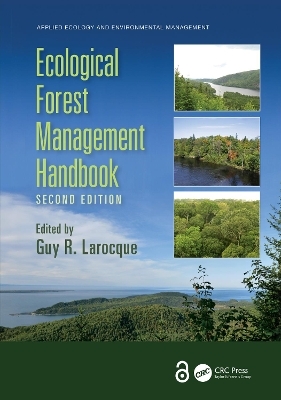
Ecological Forest Management Handbook
CRC Press (Verlag)
978-1-032-55517-1 (ISBN)
The second edition of Ecological Forest Management Handbook continues to provide forestry professionals and students with basic principles of ecological forest management and their applications at regional and site-specific levels. Thoroughly updated and revised, the handbook addresses numerous topics and explains that ecological forest management is a complex process that requires broad ecological knowledge. It discusses how to develop adaptive management scenarios to harvest resources in a sustainable way and provide ecosystem services and social functions. It includes new studies on ecological indicators, the carbon cycle, and ecosystem simulation models for various forest types: boreal, temperate, and tropical forests.
NEW IN THE SECOND EDITION
Provides a comprehensive collection of sustainable forest management principles and their applications
Covers new ecological indicators that can be applied to address forest environmental issues
Includes all types of models: empirical, gap, and process-based models
Explains several basic ecological and management concepts in a clear, easy-to- understand manner
This handbook is intended for researchers, academics, professionals, and undergraduate and graduate students studying and/or involved in the management of forest ecosystems.
Chapters 16 and 18 of this book are available for free in PDF format as Open Access from the individual product page at www.taylorfrancis.com. They have been made available under a Creative Commons Attribution-Non Commercial-No Derivatives 4.0 license.
Guy R. Larocque, PhD, is a research scientist for the Canadian Forest Service, a sector of Natural Resources Canada, at the Laurentian Forestry Centre, Quebec City, Quebec, Canada. He is also an adjunct professor in the Faculty of Natural Resources Management at Lakehead University (Thunder Bay, Ontario, Canada). Dr. Larocque is Associate Editor of Ecoscience. Until recently, he served on the editorial board of Ecological Modelling. He has published papers on productivity and succession, carbon cycles, uncertainty analysis, and the development of empirical, succession (gap), and process-based models for forest ecosystems and was Guest Editor of special issues in Ecological Modelling, Écoscience and Forests.
Section I: Forest Management Concepts. 1. Ecological Forestry Derived from Knowledge on Natural Disturbances. 2. Triad Forest Management: Local Fix or Global Solution? 3. Forest Wildlife Management. 4. External Drivers of Changes Challenging Forestry: Political and Social Issues at Stake. 5. Ecosystem Services in Ecological Forest Management. Section II: Forest Models. 6. Growth and Yield Models for Predicting Tree and Stand Productivity. 7. Forest Succession Models. 8. Process-Based Models: A Synthesis of Models and Applications to Address Environmental and Management Issues. 9. Modeling Forest Carbon Budgets toward Ecological Forest Management: Challenges and Future Directions. 10. Modeling the Impacts of Pest Damage: Case Studies for Conifers in British Columbia, Canada. Section III: Ecological Indicators. 11. Assessing Abundance, Biomass, and Complexity in the Context of Ecological Forest Management. 12. Considering Forest Biodiversity Indicators within the Pressure, State, Benefits, and Response Framework. 13. Indicators of Forest Ecosystem Integrity. 14. Criteria and Indicators of Sustainable Forest Management. 15. Indicating Forest Ecosystem and Stand Productivity: From Deductive to Inductive Concepts. 16. Modeling Forest Floor Biomass and N Accumulations and Related Turnover Rates. 17. Forest Ecosystem Health and Biotic Disturbances: Perspectives on Indicators and Management Approaches. Section IV: Addressing Ecological and Socioeconomic Issues. 18. Application of Surface Modeling for Large Regions: A Case Study for Forest Carbon Stocks in China. 19. Comprehensive Analysis of Land Tenure Effects on the Structure and Services of Regional Forest Ecosystems. 20. Forest Management and Climate Change: Adaptive Measures for the Temperate–Boreal Interface of Eastern North America.
| Erscheinungsdatum | 23.08.2024 |
|---|---|
| Reihe/Serie | Applied Ecology and Environmental Management |
| Zusatzinfo | 49 Tables, black and white; 27 Line drawings, color; 71 Line drawings, black and white; 12 Halftones, color; 18 Halftones, black and white; 39 Illustrations, color; 89 Illustrations, black and white |
| Verlagsort | London |
| Sprache | englisch |
| Maße | 178 x 254 mm |
| Gewicht | 1240 g |
| Themenwelt | Naturwissenschaften ► Biologie ► Botanik |
| Weitere Fachgebiete ► Land- / Forstwirtschaft / Fischerei | |
| ISBN-10 | 1-032-55517-3 / 1032555173 |
| ISBN-13 | 978-1-032-55517-1 / 9781032555171 |
| Zustand | Neuware |
| Informationen gemäß Produktsicherheitsverordnung (GPSR) | |
| Haben Sie eine Frage zum Produkt? |
aus dem Bereich


